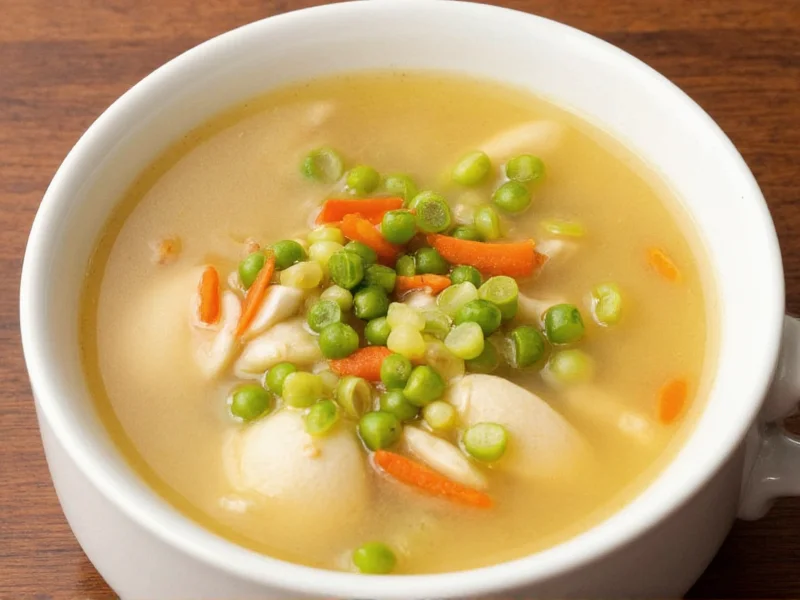The simplest way to make authentic egg drop soup is to simmer chicken broth with ginger and green onions, slowly pour in beaten eggs while stirring gently in one direction, then season with salt and white pepper. This creates delicate egg ribbons in under 15 minutes with just 6 basic ingredients.
Making perfect egg drop soup at home is easier than you think and requires minimal ingredients you likely already have in your pantry. This classic Chinese comfort food features silky egg ribbons suspended in a light, flavorful broth. The key to success lies in proper technique rather than complex ingredients. Whether you're cooking for a weeknight dinner or seeking a soothing remedy when feeling under the weather, this easy egg drop soup recipe for beginners delivers restaurant-quality results every time.
Essential Ingredients for Authentic Egg Drop Soup
While regional variations exist across Chinese cuisine, the foundation of traditional egg drop soup remains consistent. Quality ingredients make a noticeable difference in this simple dish where each component shines.
| Ingredient | Amount | Why It Matters |
|---|---|---|
| Chicken broth | 4 cups | Homemade provides best flavor; low-sodium store-bought works well too |
| Eggs | 2 large | Fresh eggs create smoother ribbons; beat thoroughly but gently |
| Fresh ginger | 1-inch piece, sliced | Essential for authentic flavor; don't substitute ground ginger |
| Green onions | 2, sliced | Adds freshness; reserve some for garnish |
| Soy sauce | 1 tbsp | Use light soy sauce for proper seasoning without darkening broth |
| Sesame oil | 1 tsp | Add just before serving for aromatic finish |
Step-by-Step Instructions for Perfect Egg Drop Soup
Follow these precise steps to achieve the signature silky egg ribbons that distinguish authentic egg drop soup from scrambled egg soup. The technique for smooth egg ribbons is more important than ingredient complexity.
- Prepare the broth base: In a medium saucepan, combine chicken broth, ginger slices, and half the green onions. Bring to a gentle simmer over medium heat (do not boil vigorously).
- Season properly: Add soy sauce and white pepper. Taste and adjust seasoning as needed. Remove ginger slices if desired before adding eggs.
- Prepare the eggs: In a separate bowl, beat eggs thoroughly until completely uniform in color and texture. This egg drop soup preparation tip prevents uneven cooking.
- Create the egg ribbons: Reduce heat to low so broth is barely simmering. Slowly pour beaten eggs into the broth in a thin, steady stream while gently stirring the broth in one direction with your other hand.
- Finish perfectly: Remove from heat immediately once eggs form ribbons (about 30 seconds). Stir in sesame oil and remaining green onions. Serve immediately.
Mastering the Egg Technique: Common Mistakes to Avoid
Many home cooks struggle with achieving the proper egg texture in egg drop soup. Understanding these egg drop soup troubleshooting tips will transform your results:
- Broth temperature is critical: If broth boils too vigorously when adding eggs, you'll get scrambled eggs instead of ribbons. Maintain a gentle simmer (180-190°F/82-88°C).
- Pouring method matters: Pour eggs slowly in a thin stream while continuously stirring the broth in one direction. This creates long, delicate ribbons rather than clumps.
- Don't overcook: Remove soup from heat as soon as eggs set. Residual heat will continue cooking the eggs.
- Avoid cornstarch unless necessary: Authentic versions don't use thickeners. If your broth seems too thin, reduce it by simmering longer before adding eggs rather than using cornstarch.
Variations for Different Dietary Needs and Preferences
While traditional egg drop soup is naturally gluten-free and relatively low-calorie, these egg drop soup variations for different dietary needs accommodate various preferences:
- Vegan option: Substitute vegetable broth for chicken broth and use 2 tablespoons of blended silken tofu instead of eggs for similar texture.
- Extra protein: Add cooked shredded chicken or tofu cubes before serving.
- Vegetable boost: Include finely chopped mushrooms, spinach, or bamboo shoots during broth simmering.
- Spicy version: Add a few drops of chili oil or a pinch of red pepper flakes with the seasonings.
Serving and Storage Recommendations
Egg drop soup tastes best when served immediately after preparation, as the egg ribbons continue to firm up over time. For optimal enjoyment:
- Pair with steamed rice and other Chinese dishes like stir-fried vegetables or dumplings
- Garnish with additional sliced green onions and a tiny drizzle of sesame oil
- Store leftovers in an airtight container in the refrigerator for up to 2 days
- Reheat gently on the stove (not in microwave) to prevent further egg cooking
Why This Method Works: The Science Behind Perfect Egg Drop Soup
Understanding the science of egg drop soup preparation helps you master this simple dish. When egg proteins meet warm liquid (around 160°F/71°C), they begin to coagulate. The gentle stirring while pouring creates long, thin strands that set quickly in the hot broth. Adding eggs to boiling broth causes rapid, uneven coagulation resulting in scrambled eggs rather than ribbons. The slow incorporation method allows controlled protein setting, creating the signature silky texture that defines authentic egg drop soup.











 浙公网安备
33010002000092号
浙公网安备
33010002000092号 浙B2-20120091-4
浙B2-20120091-4